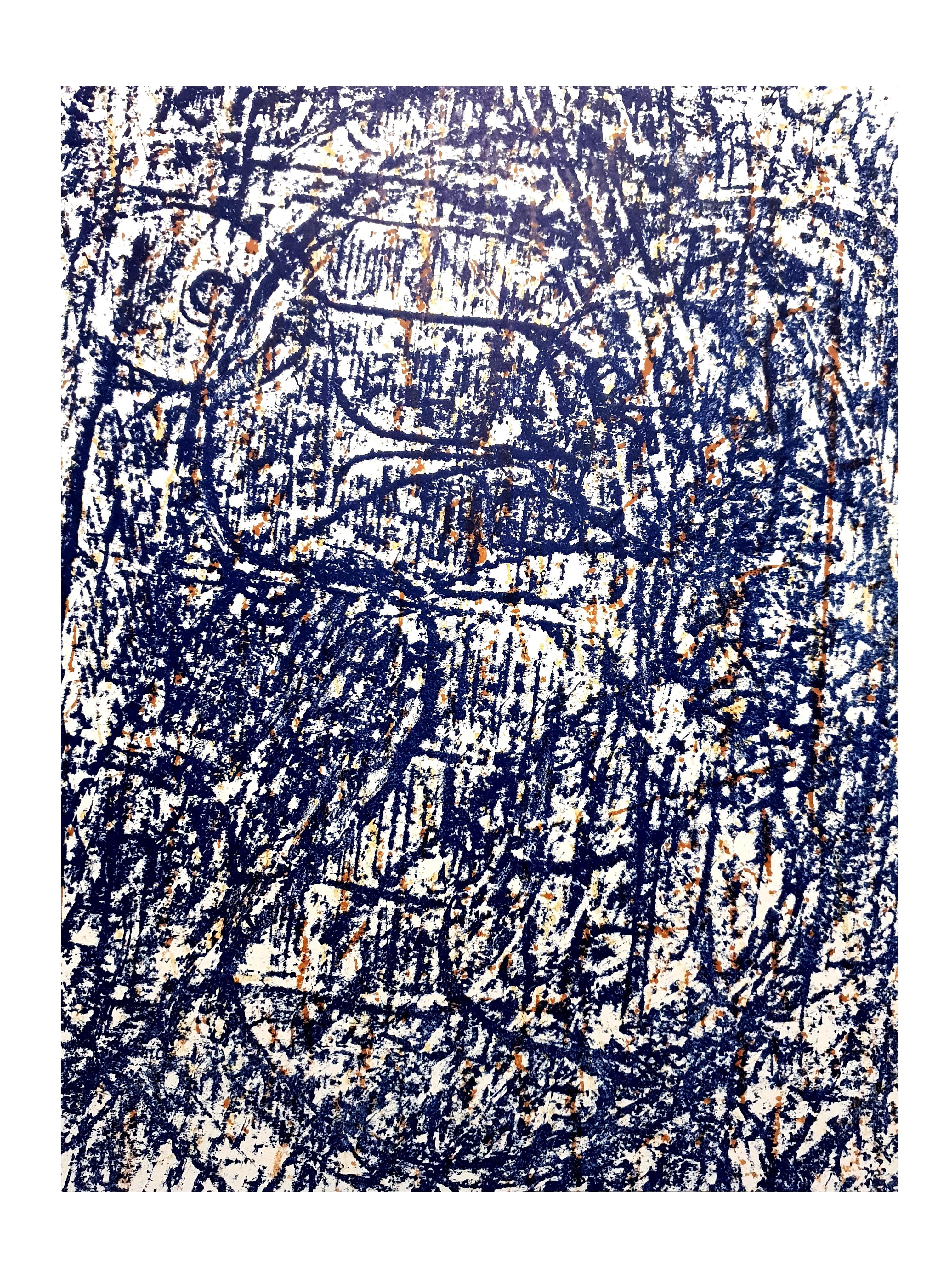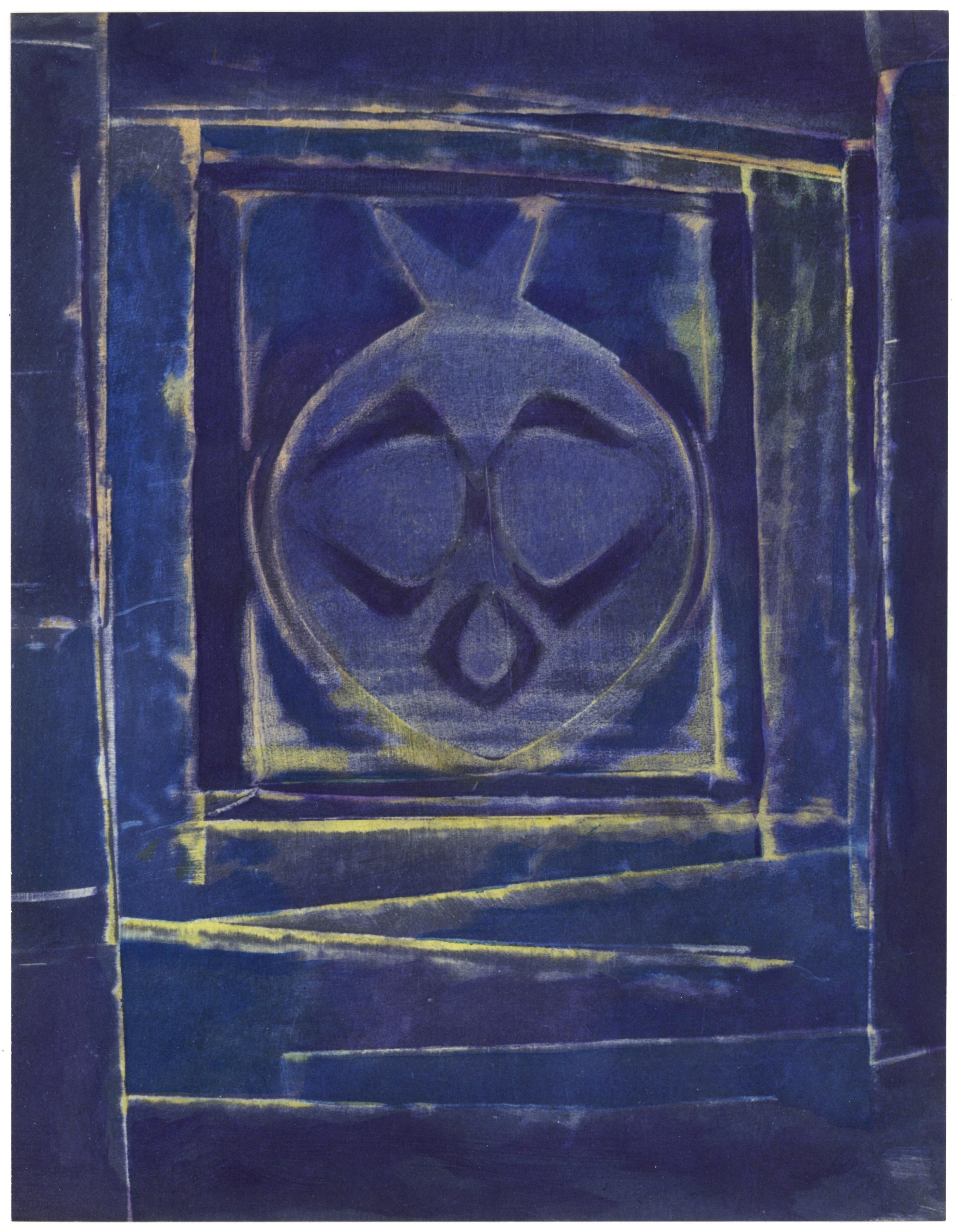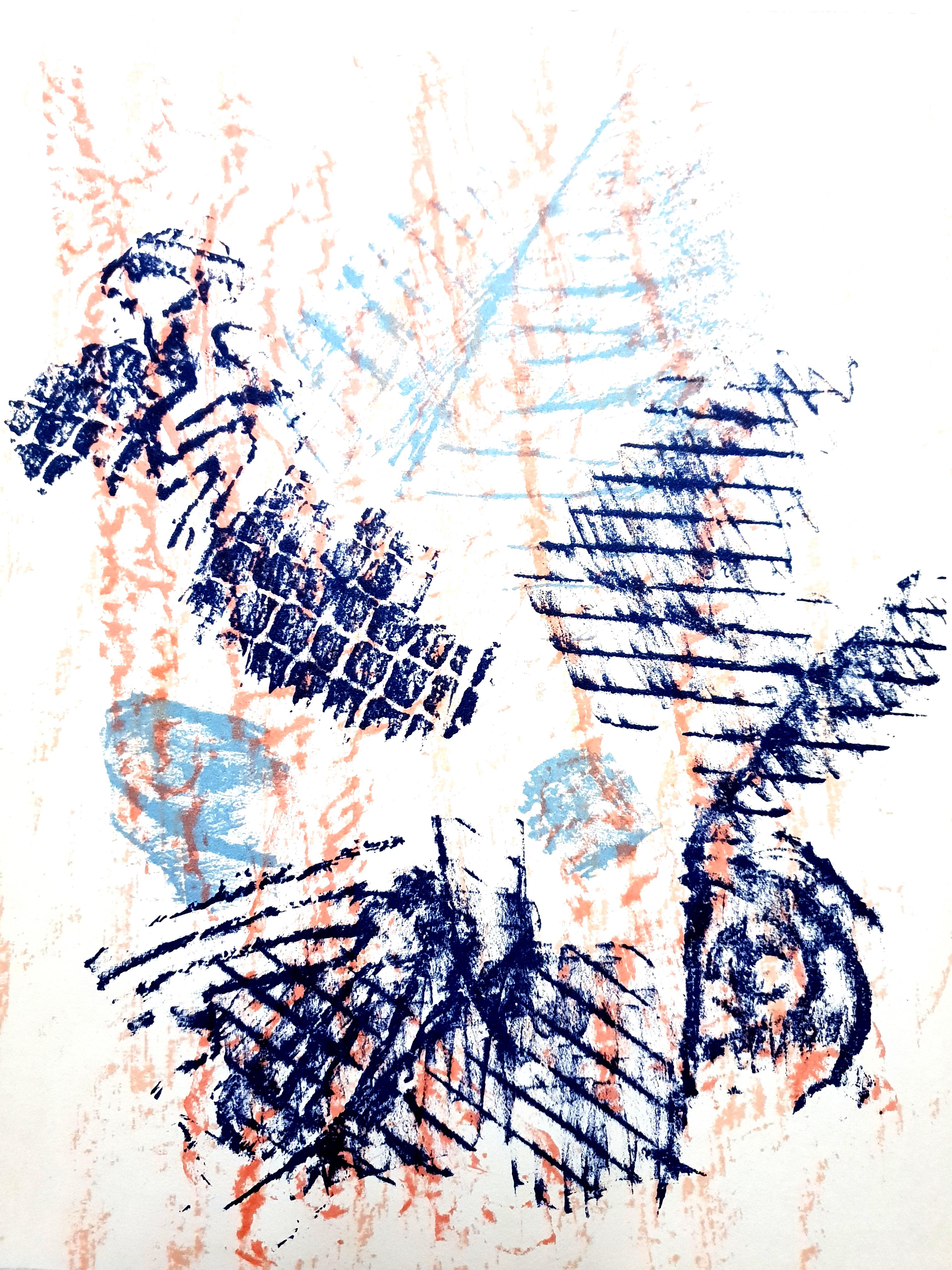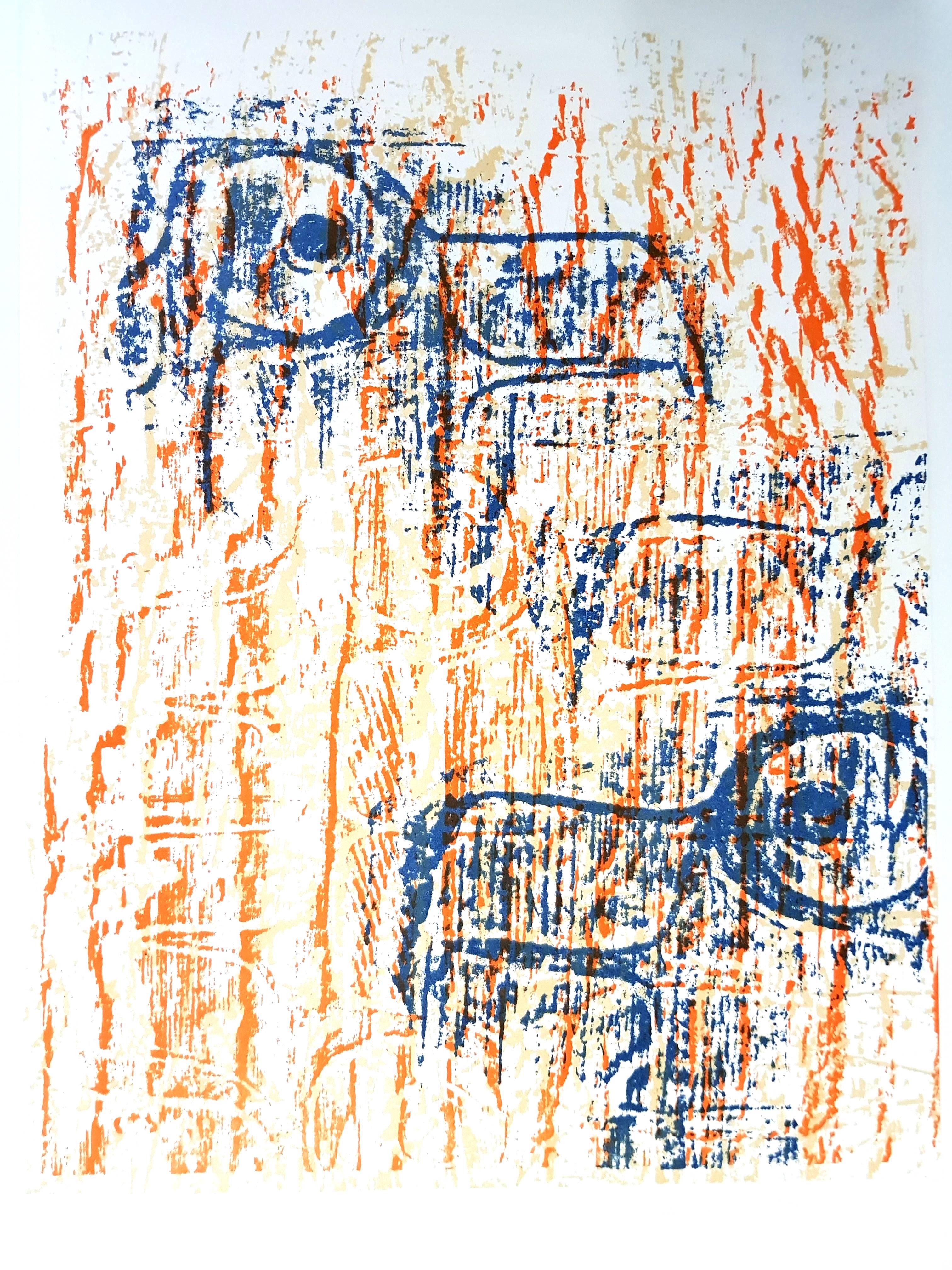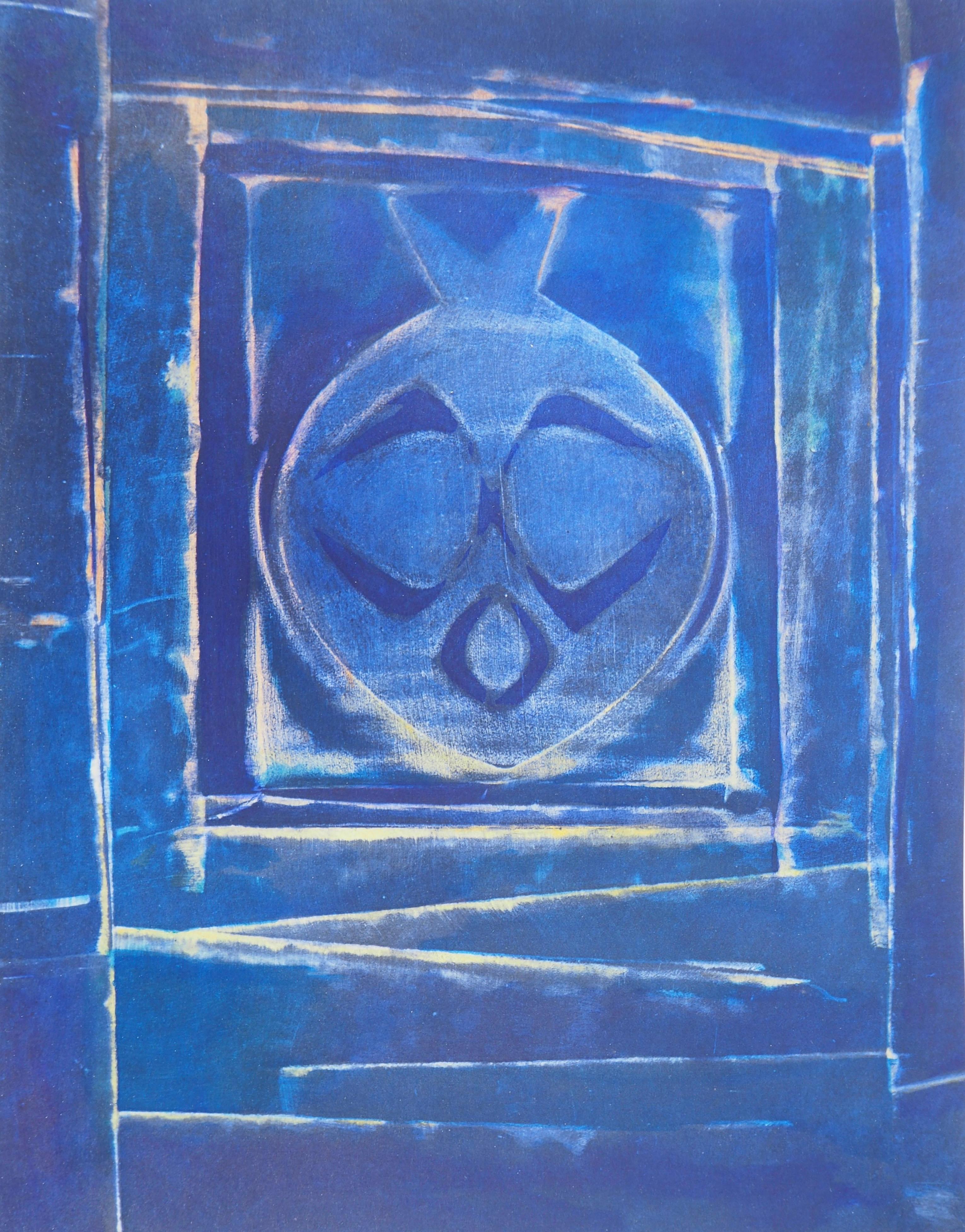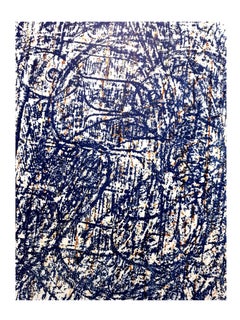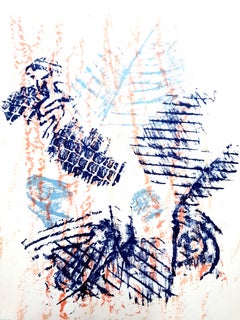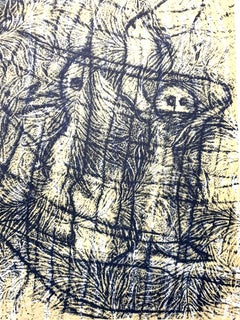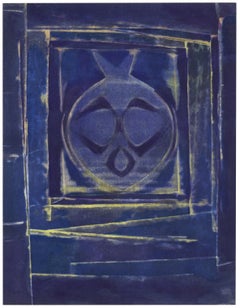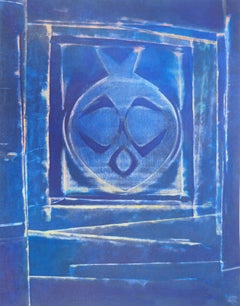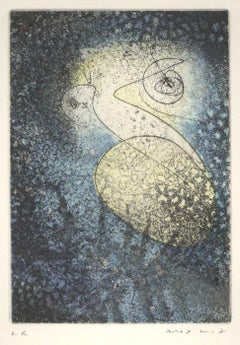Items Similar to (after) Max Ernst - Blue Bird - Stencil
Want more images or videos?
Request additional images or videos from the seller
1 of 5
(after) Max Ernst(after) Max Ernst - Blue Bird - Stencil1958
1958
$831.18
£628.17
€700
CA$1,161.09
A$1,263.14
CHF 666.54
MX$15,191.49
NOK 8,408.17
SEK 7,825.13
DKK 5,332.41
About the Item
Max Ernst (after) - Blue Bird - Stencil
Published in the deluxe art review, XXe Siecle, 1958
Dimensions: 32 x 25 cm
Publisher: G. di San Lazzaro.
Max Ernst was born in Bruhl, a place near Cologne, in Germany. He was raised in a strict Catholic family, and both of his parents were disciplinarians who were dedicated to training their children into God-fearing and talented individuals. Although his father was deaf, Ernst learned so much from him, particularly when it comes to painting. In fact, much of his early years were lived under the inspiration of his father who was also a teacher. He was the one who introduced painting to Ernst at an early age.
In 1914, Ernst attended the University of Bonn where he studied philosophy. However, he eventually dropped out of school because he was more interested in the arts. He claimed that his primary sources of interest included anything that had something to do with painting. Moreover, he became fascinated with psychology, among other subjects in school.
Primarily, Ernst's love for painting was the main reason why he became deeply interested with this craft and decided to pursue it later on in his life. During his early years, he became familiar with the works of some of the greatest artists of all time including Claude Monet, Paul Cezanne and Vincent van Gogh. He was also drawn to themes such as fantasy and dream imagery, which were among the common subjects of the works of Giorgio de Chirico.
During World War I, Ernst was forced to join the German Army, and he became a part of the artillery division that exposed him greatly to the drama of warfare. A soldier in the War, Ernst emerged deeply traumatized and highly critical of western culture. These charged sentiments directly fed into his vision of the modern world as irrational, an idea that became the basis of his artwork. Ernst's artistic vision, along with his humor and verve come through strongly in his Dada and Surrealists works; Ernst was a pioneer of both movements.
It was Ernst's memories of the war and his childhood that helps him create absurd, yet interesting scenes in his artworks. Soon, he took his passion for the arts seriously when he returned to Germany after the war. With Jean Arp, a poet and artist, Ernst formed a group for artists in Cologne. He also developed a close relationship with fellow artists in Paris who propagated Avant-Garde artworks.
In 1919, Ernst started creating some of his first collages, where he made use of various materials including illustrated catalogs and some manuals that produced a somewhat futuristic image. His unique masterpieces allowed Ernst to create his very own world of dreams and fantasy, which eventually helped heal his personal issues and trauma. In addition to painting and creating collages, Ernst also edited some journals. He also made a few sculptures that were rather queer in appearance.
In 1920s, influenced by the writings of psychologist Sigmund Freud, the literary, intellectual, and artistic movement called Surrealism sought a revolution against the constraints of the rational mind; and by extension, they saw the rules of a society as oppressive. Surrealism also embraces a Marxist ideology that demands an orthodox approach to history as a product of the material interaction of collective interests, and many renown Surrealism artists later on became 20th century Counterculture symbols such as Marxist Che Guevara. In 1922 Ernst moved to Paris, where the surrealists were gathering around Andre Breton. In 1923 Ernst finished Men Shall Know Nothing of This, known as the first Surrealist painting. Ernst was one of the first artists who apply The Interpretation of Dreams by Freud to investigate his deep psyche in order to explore the source of his own creativity. While turning inwards unto himself, Ernst was also tapping into the universal unconscious with its common dream imagery.
Despite his strange styles, Ernst gained quite a reputation that earned him some followers throughout his life. He even helped shape the trend of American art during the mid-century, thanks to his brilliant and extraordinary ideas that were unlike those of other artists during his time. Ernst also became friends with Peggy Guggenheim, which inspired him to develop close ties with the abstract expressionists.
When Ernst lived in Sedona, he became deeply fascinated with the Southwest Native American navajo art. In fact, the technique used in this artwork inspired him and paved the way for him to create paintings that depicted this style. Thus, Ernst became a main figure of this art technique, including the rituals and spiritual traditions included in this form of art. Pollock, aside from the other younger generations of abstract expressionists, was also inspired by sand painting of the Southwest Native Americans.
Meanwhile, Germany was completely under control by the Nazi Party during the year 1933. In 1937, Hitler was able to gather as much as 16,000 avant-garde artworks that were originally in display in the national museums of Germany. He also ordered to ship about 650 artworks to Munich in preparation for his art exhibition called the Degenerate Art or Degenerate Kunst. In the said art exhibition, Ernst had about 2 paintings that were on display. However, these 2 artworks were reported to have disappeared, with the possibility of have been destroyed.
Soon, Ernst decided to leave France and headed to New York to start a new life after becoming interned as a German national thrice. In New York, he joined Piet Mondrian and Marcel Duchamp, who were his fellow avant-garde artists from Europe. With these two artists, Ernst inspired a number of aspiring and professional American artists during that period.
Furthermore, it was in the United States where he met the gallery owner and socialite named Peggy Guggenheim, who eventually became Ernst's third wife. It was Guggenheim who paved the way for Ernst to enter the bustling art scene in New York.
What captivated American artists about Ernst's works was his evident rejection of conventional styles and imageries in painting. These techniques were largely gained from his father's own styles, which he refused to follow in his later works. As young American artists were more interested in fresh and novel approaches to painting, this Ernst's unique style captured the attention of painters who became exposed to his artworks.
In particular, Jackson Pollock was enthralled upon seeing the extraordinary works of Ernst. Hence, the young artist became one of Ernst's followers, among a few others. Specifically, it was Ernst's collage aspects in his paintings that fascinated those who viewed his masterpieces. Additionally, the German artist was able to encapsulate the unconscious with his experimentation with automatic writing and autonomism.
In his later years, he divorced Guggenheim and married Dorothea Tanning, who was a surrealist painter based in Sedona, in Arizona. The couple soon moved to France, in 1953 and settled there. A year after, Ernst receive an award at the Venice Biennale, which was a prestigious awards contest.
Ernst, alongside his wife Tanning, became very active as an artist. They toured to various places throughout the world to learn more about the different art techniques and inspired several artists who witnessed their unique pieces. Over the years there have been many artists associated with Surrealism which continues to exert its influence on art to this day. However, those major figures who were responsible for creating the golden age of Surrealism were Max Ernst, Joan Miro, Salvador Dali and Rene Magritte. In 1976, Ernst passed away, yet his legacy lived on as he continued to become a source of inspiration for artists throughout the world.
- Creator:(after) Max Ernst (1891 - 1976, German)
- Creation Year:1958
- Dimensions:Height: 12.6 in (32 cm)Width: 9.45 in (24 cm)Depth: 0.04 in (1 mm)
- Medium:
- Movement & Style:
- Period:
- Condition:
- Gallery Location:Collonge Bellerive, Geneve, CH
- Reference Number:1stDibs: LU16123591972
(after) Max Ernst
Max Ernst (2 April 1891 – 1 April 1976) was a German painter, sculptor artist and poet. Ernst, living through two World Wars along with other artists who forever transformed the possibilities of human expression, was one of the founding fathers for the (Cologne) Dada and Surrealist movements. After the German occupation of France in WWII, Ernst was arrested by the Gestapo as an "undesirable foreigner" but managed to escape and flee to America with the help of Peggy Guggenheim and friend journalist Varian Fry. Ernst and Peggy Guggenheim arrived in the United States in 1941 and were married at the end of the year. Along with other artists and friends (Marcel Duchamp and Marc Chagall) who had fled from the war and lived in New York City, Ernst helped inspire the development of Abstract expressionism. His marriage to Guggenheim did not last and in Beverly Hills, California in October 1946, in a double ceremony with Man Ray and Juliet P. Browner, he married Dorothea Tanning. For Ernst there was always an emphasis on ceaseless experimentation. He began his pursuit of radical new techniques that went "beyond painting" to articulate the irrational and unexplainable in the wake of World Wars I and II. His unconventional methods experiment with free association writing and the techniques of frottage, created from a rubbing from a textured surface; grattage, involving scratching at the surface of a painting; and decalcomania, which involves altering a wet painting by pressing a second surface against it and taking it away.
About the Seller
4.9
Gold Seller
Premium sellers maintaining a 4.3+ rating and 24-hour response times
Established in 2015
1stDibs seller since 2015
970 sales on 1stDibs
Typical response time: 1 hour
- ShippingRetrieving quote...Shipping from: Collonge Bellerive, Geneve, Switzerland
- Return Policy
More From This Seller
View AllMax Ernst - Abstract Birds - Original Lithograph
By Max Ernst
Located in Collonge Bellerive, Geneve, CH
Max Ernst - Birds - Original Lithograph
Birds, 1962
Dimensions: 32 x 24 cm
From the art review XXe siècle
Unsigned and unumbered as issued
Category
1960s Surrealist Animal Prints
Materials
Lithograph
Max Ernst - Birds - Original Lithograph
By Max Ernst
Located in Collonge Bellerive, Geneve, CH
Max Ernst - Birds - Original Lithograph
Birds, 1964
Dimensions: 32 x 24 cm
From the art review XXe siècle
Unsigned and unumbered as issued
Category
1960s Surrealist Animal Prints
Materials
Lithograph
Max Ernst - Birds - Original Lithograph
By Max Ernst
Located in Collonge Bellerive, Geneve, CH
Max Ernst - Birds - Original Lithograph
Birds, 1964 (BNF, 63)
Dimensions: 32 x 24 cm
Revue Art de France
ax Ernst was born in Bruhl, a place near Cologne, in Germany. He was raised in a strict Catholic family, and both of his parents were disciplinarians who were dedicated to training their children into God-fearing and talented individuals. Although his father was deaf, Ernst learned so much from him, particularly when it comes to painting. In fact, much of his early years were lived under the inspiration of his father who was also a teacher. He was the one who introduced painting to Ernst at an early age.
In 1914, Ernst attended the University of Bonn where he studied philosophy. However, he eventually dropped out of school because he was more interested in the arts. He claimed that his primary sources of interest included anything that had something to do with painting. Moreover, he became fascinated with psychology, among other subjects in school.
Primarily, Ernst's love for painting was the main reason why he became deeply interested with this craft and decided to pursue it later on in his life. During his early years, he became familiar with the works of some of the greatest artists of all time including Claude Monet, Paul Cezanne and Vincent van Gogh. He was also drawn to themes such as fantasy and dream imagery, which were among the common subjects of the works of Giorgio de Chirico.
During World War I, Ernst was forced to join the German Army, and he became a part of the artillery division that exposed him greatly to the drama of warfare. A soldier in the War, Ernst emerged deeply traumatized and highly critical of western culture. These charged sentiments directly fed into his vision of the modern world as irrational, an idea that became the basis of his artwork. Ernst's artistic vision, along with his humor and verve come through strongly in his Dada and Surrealists works; Ernst was a pioneer of both movements.
It was Ernst's memories of the war and his childhood that helps him create absurd, yet interesting scenes in his artworks. Soon, he took his passion for the arts seriously when he returned to Germany after the war. With Jean Arp, a poet and artist, Ernst formed a group for artists in Cologne. He also developed a close relationship with fellow artists in Paris who propagated Avant-Garde artworks.
In 1919, Ernst started creating some of his first collages, where he made use of various materials including illustrated catalogs and some manuals that produced a somewhat futuristic image. His unique masterpieces allowed Ernst to create his very own world of dreams and fantasy, which eventually helped heal his personal issues and trauma. In addition to painting and creating collages, Ernst also edited some journals. He also made a few sculptures that were rather queer in appearance.
In 1920s, influenced by the writings of psychologist Sigmund Freud, the literary, intellectual, and artistic movement called Surrealism sought a revolution against the constraints of the rational mind; and by extension, they saw the rules of a society as oppressive. Surrealism also embraces a Marxist ideology that demands an orthodox approach to history as a product of the material interaction of collective interests, and many renown Surrealism artists later on became 20th century Counterculture symbols such as Marxist Che Guevara. In 1922 Ernst moved to Paris, where the surrealists were gathering around Andre Breton. In 1923 Ernst finished Men Shall Know Nothing of This, known as the first Surrealist painting. Ernst was one of the first artists who apply The Interpretation of Dreams by Freud to investigate his deep psyche in order to explore the source of his own creativity. While turning inwards unto himself, Ernst was also tapping into the universal unconscious with its common dream imagery.
Despite his strange styles, Ernst gained quite a reputation that earned him some followers throughout his life. He even helped shape the trend of American art during the mid-century, thanks to his brilliant and extraordinary ideas that were unlike those of other artists during his time. Ernst also became friends with Peggy Guggenheim, which inspired him to develop close ties with the abstract expressionists.
When Ernst lived in Sedona, he became deeply fascinated with the Southwest Native American navajo art. In fact, the technique used in this artwork inspired him and paved the way for him to create paintings that depicted this style. Thus, Ernst became a main figure of this art technique, including the rituals and spiritual traditions included in this form of art. Pollock, aside from the other younger generations of abstract expressionists, was also inspired by sand painting of the Southwest...
Category
1960s Surrealist Animal Prints
Materials
Lithograph
Max Ernst - Composition - Original Lithograph
By Max Ernst
Located in Collonge Bellerive, Geneve, CH
Max Ernst - Composition - Original Lithograph
1958
Dimensions: 32 x 24 cm
XXe siècle
Unsigned and unnumbered, as issued
Max Ernst was born in Bruhl, a place near Cologne, in Germany. He was raised in a strict Catholic family, and both of his parents were disciplinarians who were dedicated to training their children into God-fearing and talented individuals. Although his father was deaf, Ernst learned so much from him, particularly when it comes to painting. In fact, much of his early years were lived under the inspiration of his father who was also a teacher. He was the one who introduced painting to Ernst at an early age.
In 1914, Ernst attended the University of Bonn where he studied philosophy. However, he eventually dropped out of school because he was more interested in the arts. He claimed that his primary sources of interest included anything that had something to do with painting. Moreover, he became fascinated with psychology, among other subjects in school.
Primarily, Ernst's love for painting was the main reason why he became deeply interested with this craft and decided to pursue it later on in his life. During his early years, he became familiar with the works of some of the greatest artists of all time including Claude Monet, Paul Cezanne and Vincent van Gogh. He was also drawn to themes such as fantasy and dream imagery, which were among the common subjects of the works of Giorgio de Chirico.
During World War I, Ernst was forced to join the German Army, and he became a part of the artillery division that exposed him greatly to the drama of warfare. A soldier in the War, Ernst emerged deeply traumatized and highly critical of western culture. These charged sentiments directly fed into his vision of the modern world as irrational, an idea that became the basis of his artwork. Ernst's artistic vision, along with his humor and verve come through strongly in his Dada and Surrealists works; Ernst was a pioneer of both movements.
It was Ernst's memories of the war and his childhood that helps him create absurd, yet interesting scenes in his artworks. Soon, he took his passion for the arts seriously when he returned to Germany after the war. With Jean Arp, a poet and artist, Ernst formed a group for artists in Cologne. He also developed a close relationship with fellow artists in Paris who propagated Avant-Garde artworks.
In 1919, Ernst started creating some of his first collages, where he made use of various materials including illustrated catalogs and some manuals that produced a somewhat futuristic image. His unique masterpieces allowed Ernst to create his very own world of dreams and fantasy, which eventually helped heal his personal issues and trauma. In addition to painting and creating collages, Ernst also edited some journals. He also made a few sculptures that were rather queer in appearance.
In 1920s, influenced by the writings of psychologist Sigmund Freud, the literary, intellectual, and artistic movement called Surrealism sought a revolution against the constraints of the rational mind; and by extension, they saw the rules of a society as oppressive. Surrealism also embraces a Marxist ideology that demands an orthodox approach to history as a product of the material interaction of collective interests, and many renown Surrealism artists later on became 20th century Counterculture symbols such as Marxist Che Guevara. In 1922 Ernst moved to Paris, where the surrealists were gathering around Andre Breton. In 1923 Ernst finished Men Shall Know Nothing of This, known as the first Surrealist painting. Ernst was one of the first artists who apply The Interpretation of Dreams by Freud to investigate his deep psyche in order to explore the source of his own creativity. While turning inwards unto himself, Ernst was also tapping into the universal unconscious with its common dream imagery.
Despite his strange styles, Ernst gained quite a reputation that earned him some followers throughout his life. He even helped shape the trend of American art during the mid-century, thanks to his brilliant and extraordinary ideas that were unlike those of other artists during his time. Ernst also became friends with Peggy Guggenheim, which inspired him to develop close ties with the abstract expressionists.
When Ernst lived in Sedona, he became deeply fascinated with the Southwest Native American navajo art. In fact, the technique used in this artwork inspired him and paved the way for him to create paintings that depicted this style. Thus, Ernst became a main figure of this art technique, including the rituals and spiritual traditions included in this form of art. Pollock, aside from the other younger generations of abstract expressionists, was also inspired by sand painting of the Southwest...
Category
1960s Surrealist Animal Prints
Materials
Lithograph
Max Ernst - The Soldier - Original Lithograph
By Max Ernst
Located in Collonge Bellerive, Geneve, CH
Max Ernst (1891-1976)
Georges Ribemont-Dessaignes, La Ballade du Soldat, Pierre Chave, Vence, 1972
Colour lithographs on Arches paper
1972
Dimensions: 40 x 30 cm
Reference: Spies &...
Category
1970s Modern Figurative Prints
Max Ernst - The Soldier - Original Lithograph
By Max Ernst
Located in Collonge Bellerive, Geneve, CH
Max Ernst (1891-1976)
Georges Ribemont-Dessaignes, La Ballade du Soldat, Pierre Chave, Vence, 1972
Colour lithographs on Arches paper
1972
Dimensions: 40 x 30 cm
Reference: Spies &...
Category
1970s Modern Figurative Prints
You May Also Like
pochoir
By (after) Max Ernst
Located in Henderson, NV
Medium: pochoir. Printed at the atelier of Daniel Jacomet in 1958 for the art revue XXe Siecle (issue number 10) published in Paris by San Lazzaro. Size: 12 3/8 x 9 1/2 inches (315 x...
Category
1950s Surrealist Abstract Prints
Materials
Lithograph
Composition with Blue Vase - Lithograph and stencil, 1958
By Max Ernst
Located in Paris, IDF
Max ERNST
Composition with Blue Vase, 1958
Lithograph and stencil (Jacomet workshop) after a painting
On wove paper 31 x 24 cm (c. 12 x 10 in)
Edited by San Lazarro, 1958
Excellent...
Category
1950s Abstract Abstract Prints
Materials
Lithograph, Stencil
Max Ernst, The Hundred Headless Woman, from XXe Siecle, 1958
By Max Ernst
Located in Southampton, NY
This exquisite lithograph and pochoir by Max Ernst (1891–1976), titled La femme 100 tetes (The Woman with 100 Heads), from the album XXe Siecle, Nouvelle serie, XXe Annee, No. 10 (do...
Category
1950s Surrealist Abstract Prints
Materials
Lithograph
$796 Sale Price
20% Off
Free Shipping
Max Ernst Untitled 1965 #107A Surrealist Etching Aquatint in colors Blue Yellow
By Max Ernst
Located in Rancho Santa Fe, CA
Max Ernst
"Untitled" 1965
Etching and aquatint in colors, on Arches paper.
7.8 x 5.39 inches
Publisher: Georges Visat, Paris. Total edition: 100 copies +...
Category
1960s Surrealist Abstract Prints
Materials
Archival Paper, Etching, Aquatint
Birds - Original lithograph (Leppien/Spies #88)
By Max Ernst
Located in Paris, IDF
Max ERNST
Birds
Original lithograph, 1963
on vellum
33 x 25 cm
REFERENCES : Catalogue raisonné Leppien/Spies # 88
Excellent condition
Category
1960s Modern Animal Prints
Materials
Lithograph
Lithographie originale pour XXe Siecle, No. 20
By Max Ernst
Located in Fairlawn, OH
Lithographie originale pour XXe Siecle, No. 20
Color lithograph, 1962
Unsigned (as issued)
From: XXe Siecle, No. 20, Christmas
Publisher: G. di San Lazzaro, Paris.
Printer: Mourlot?
Large edition: c. 1500?
Condition: Excellent/Mint
usual glue on reverse from binding in book
Image/Sheet size: 12 3/16 x 9 1/2 inches
New series of XXe Siecle
Back in Paris in 1949, Gualtieri di San Lazzaro resumed 20TH century publishing in 1951.
It hosts many of the most important writers and art critics of the 1950s and 1960s, including Alain Bosquet , Genevieve Bonnefoi, Camille Bourniquel , Georges Borgeaud, Marcel Brion , Georges Boudaille, Jacques Brosse , Michel Butor , Jean Cassou , Denys Chevalier, Pierre Courthion, Hubert Damisch , Pierre Descargues, Bernard Dorival , Jacques Dupin , Mircea Eliade , Jean-Louis Ferrier , Pierre Francastel , André Frenaud , Roger Van Gindertael...
Category
1960s Abstract Abstract Prints
Materials
Lithograph
